Cosmos flowers are ridiculously easy to grow and can bring a lot of beauty to your garden. They come in a huge range of colors and are renowned for their ability to withstand and even benefit from hot summer weather. While many cosmos plants are annuals, did you know some are perennials?
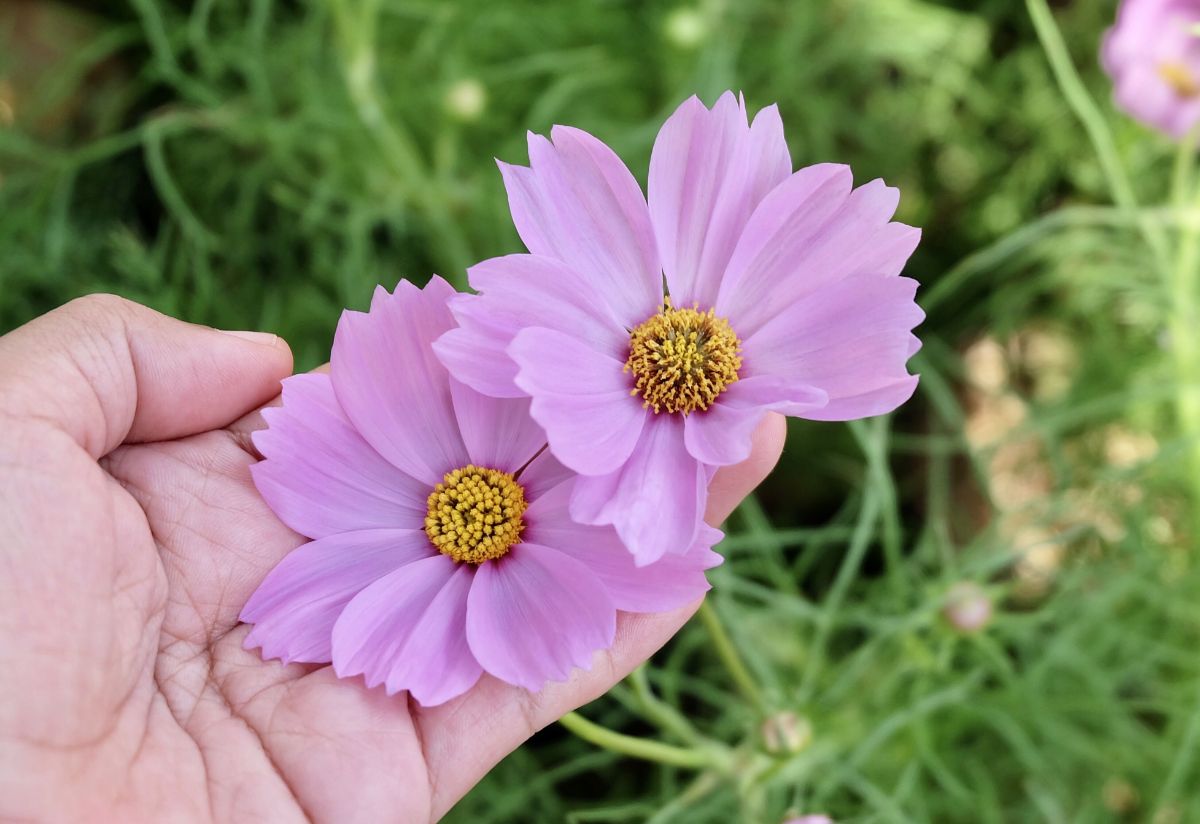
In this article, we will teach you how you can grow these daisy-like beauties successfully. Read the complete guide to learn everything you need to get started with cosmos flowers, or skip to the section you are looking for in the advanced jump below.
Jump to:
- What Are Cosmos Plants?
- Are Cosmos Plants Perennials or Annuals?
- Cosmos Plant Basics
- Where Do Cosmos Plants Grow?
- Why Grow Cosmos Plants?
- When Do Cosmos Plants Bloom?
- How Long Do Cosmos Plants Bloom?
- When to Plant Cosmos Plants
- Ideal Growing Conditions for Cosmos Plants
- How to Plant Cosmos Plants
- How to Propagate Cosmos Plants
- How to Care for Cosmos Plants
- Recommended Planting Combinations for Cosmos Plant
- Cosmos Plant Landscaping Ideas
- Recommended Cosmos Plant Varieties
- Frequently Asked Questions About Growing Cosmos Plants
- Where to Buy Cosmos Plants
What Are Cosmos Plants?
Cosmos are any plants that are in the genus with the same name. The Cosmos genus belongs to the sunflower family.
There are many species within the genus and numerous cultivars to boot. That means you can find a stupendous amount of variety when you are shopping for cosmos flowers for your garden.
Are Cosmos Plants Perennials or Annuals?
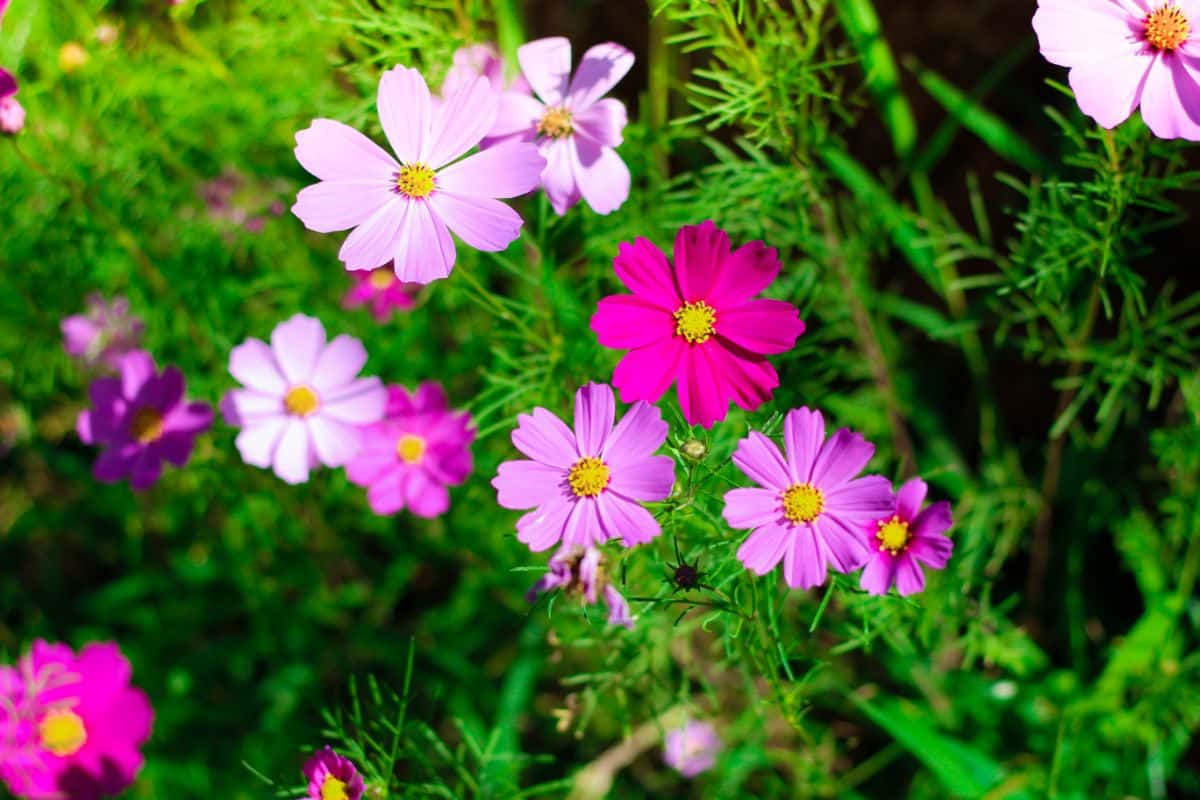
The majority of cosmos plants are annuals. They self-seed, however, which means they return every year. Technically, they come back as new plants, not the old ones, but many people understandably mistake them for perennials.
There are some types of cosmos plants that are actually perennials, however. Some examples include:
C. Altrosanguineus
C. diversifolius
C. caudatus
Of all the types of cosmos that are perennials, the one that is best known is the species C. Altrosanguineus, which is known colloquially as the “chocolate cosmos,” a reference to the brownish-reddish color of the blooms.
As this species of perennial cosmos is the one you are most likely to find for sale at your local garden center or online, it will be the focus of our post.
Cosmos Plant Basics
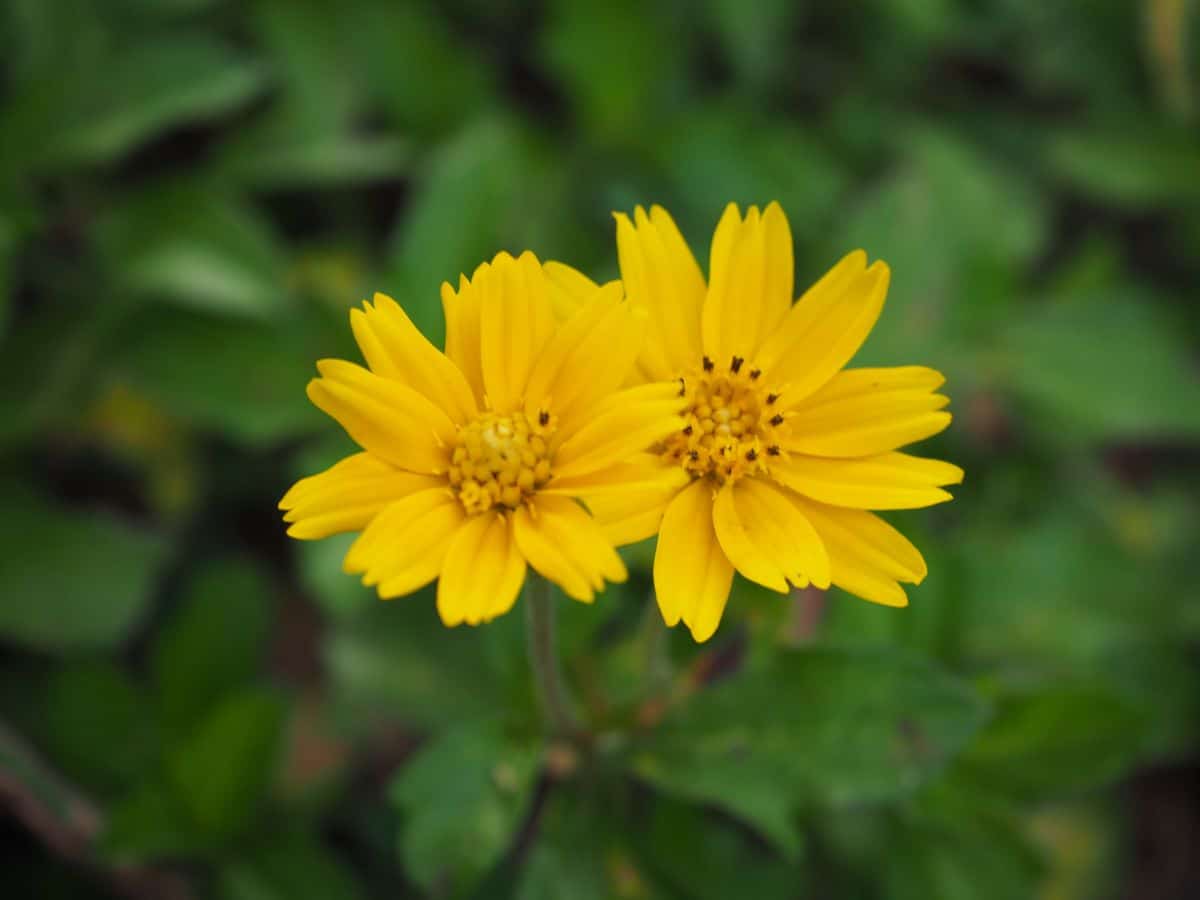
| Zones: | 6-11 |
| Blooming season: | Mid to late summer |
| Expected height: | Up to 30 inches |
| Soil: | A Moist, well-draining soil |
| Sun: | Full sun |
Where Do Cosmos Plants Grow?
Cosmos plants are native to Mexico. Today, they are cultivated throughout Central and South America, as well as the US. Even in some northern states, it can thrive and they do well in cooler climates when grown mainly as perennials. You may also find it growing in South Africa, though it was not brought there on purpose. Cosmos is cultivated in Europe as well.
Why Grow Cosmos Plants?
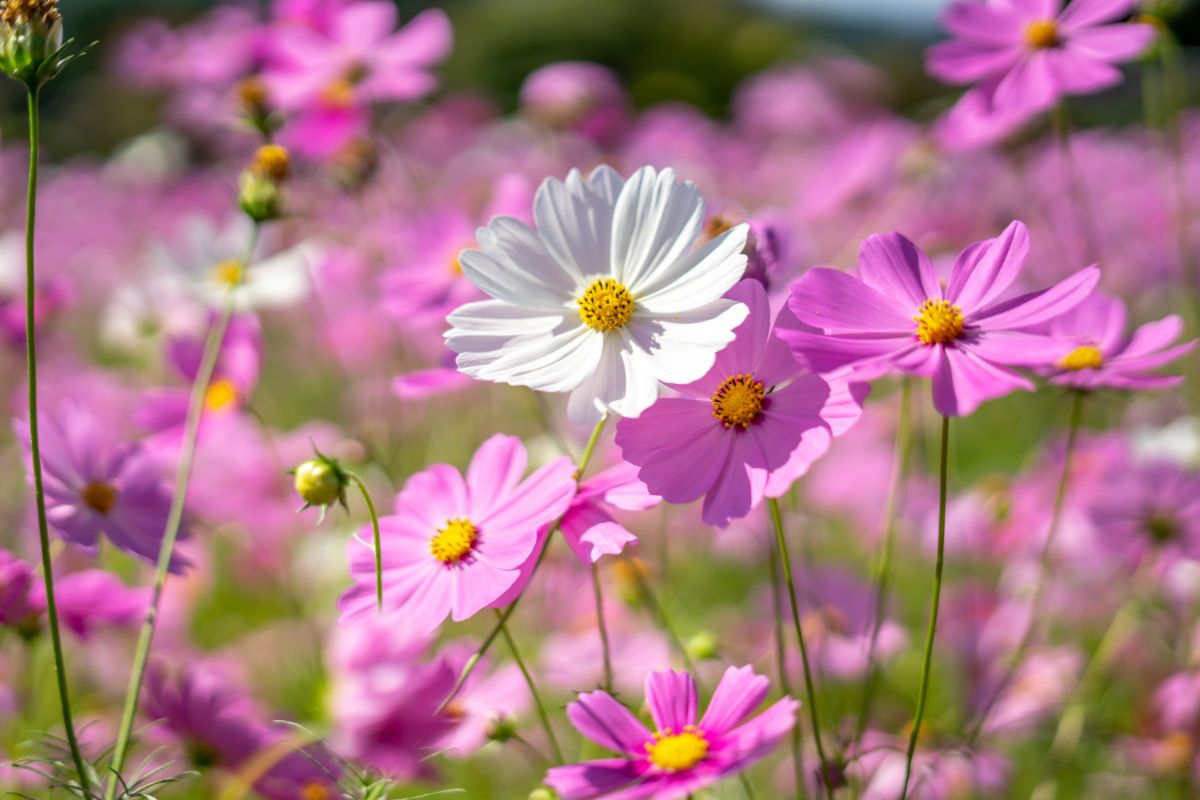
There are so many reasons to bring cosmos flower cultivars to your flower garden! Here are some of their impressive benefits:
• The feathery foliage of cosmos is just as appealing as its daisy-like blooms and can add textural interest to your garden.
• Cosmos makes wonderful cut flowers for flower arrangements. Conveniently, trimming them encourages them to produce more blooms, so that is a win-win; you get to enjoy flowers indoors while also getting more of them outdoors.
• If you like propagating plants from seeds, you will find cosmos are refreshingly easy to grow this way.
• Having a hard time growing other plants in your garden because your soil and air are too hot and dry? Cosmos actually loves these conditions and should flourish in arid soil with ease.
• While some plants in your garden may be heavy feeders, cosmos are just the opposite. You do not need to worry about complex soil preparations, and zero fertilizing is needed. They are generally low-maintenance in other respects as well, making them great for novice gardeners or those without a lot of time or energy to spend.
• If you have been searching for a safe, nontoxic plant for your garden that will not harm your dog or cat, cosmos is a fabulous option.
• The brownish-reddish flower color of chocolate cosmos is distinctive and will stand out in your flower border or anywhere else you plant these perennials in your garden. But if you want a range of colors, you can also plant some of the annual cosmos cultivars. You will find blue flowers, white flowers, pink flowers, bicolored flowers, and many more. Shorter and taller varieties are available.
• Cosmos is perfect for a butterfly garden since it is popular with these friendly insects along with other pollinators.
• You can grow cosmos in pots or in your flower beds successfully.
• Along with making great cut flowers, cosmos blooms are excellent flowers for those who enjoy the hobby of pressing and drying. Whichever of the numerous intriguing varieties of cosmos you grow, you will discover that these lovely flowers are easy to preserve and can be integrated readily into craft projects.
• Some types of cosmos are edible. The colored petals can add visual appeal to your recipes and a floral note that will enhance your recipes.
As you plant a wide variety of cosmos cultivars in your garden, no doubt you will discover other benefits of these glorious flowers as well.
When Do Cosmos Plants Bloom?
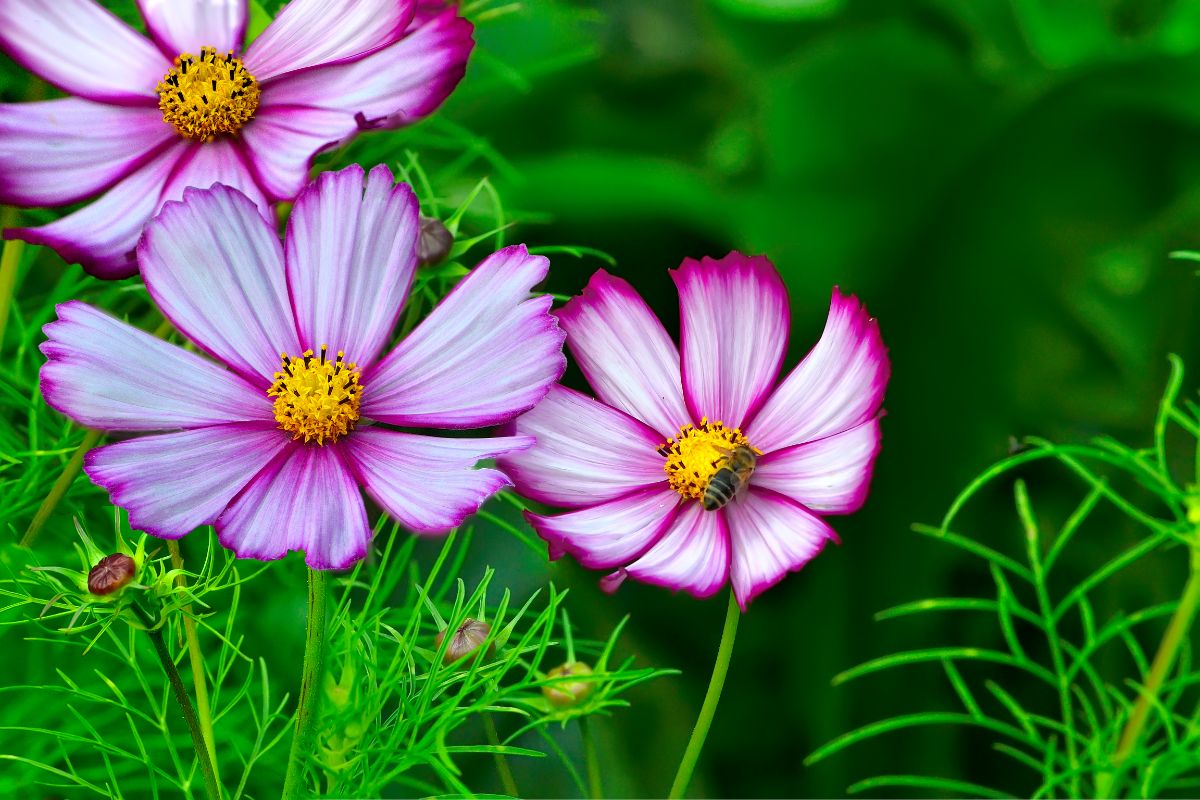
Cosmos flowers bloom during mid to late summer.
How Long Do Cosmos Plants Bloom?
The individual blooms of cosmos plants do not last long, but this plant blooms continuously. You may encourage a lengthy bloom time through deadheading.
When to Plant Cosmos Plants
Wait until your last frost is past in springtime before you plant your cosmos. May is usually the ideal month.
Ideal Growing Conditions for Cosmos Plants
How can you ensure your cosmos plants have the best chance of producing stunning blooms year after year? Let’s talk about what sun and soil conditions they prefer as well as how much water they need.
How Much Sun Do Cosmos Plants Need?

Cosmos plants like conditions that are hot and bright. That means that a sunny spot where they can receive plenty of direct sunlight is ideal. But if you live in a super hot climate, you can get away with some afternoon shade.
What Type of Soil is Right for Cosmos Plants?
Poor soil is best for cosmos; rich soils can be too much for them. American Meadows says, “Soil that is too rich will yield fast plant growth, yet can weaken stems and create a scarcity of flowers. For this reason, it's best to grow Cosmos in soil that is not overly fertilized.”
Cosmos can grow in a variety of soil types; however, whether you have sand, clay, or loam, they can do well. Of course, well-drained soil is necessary regardless of your soil’s consistency.
These plants are flexible with respect to pH; whether your soil is neutral, slightly acidic, or slightly basic, they should be happy.
How Much Water Do Cosmos Plants Need?
Follow the same rules you do for the majority of drought-tolerant plants when watering cosmos. They need extra water as they are establishing, after which they only require it once a week. Often, rain will be enough. But during dry spells, you might need to water them more than just once a week.
How to Plant Cosmos Plants
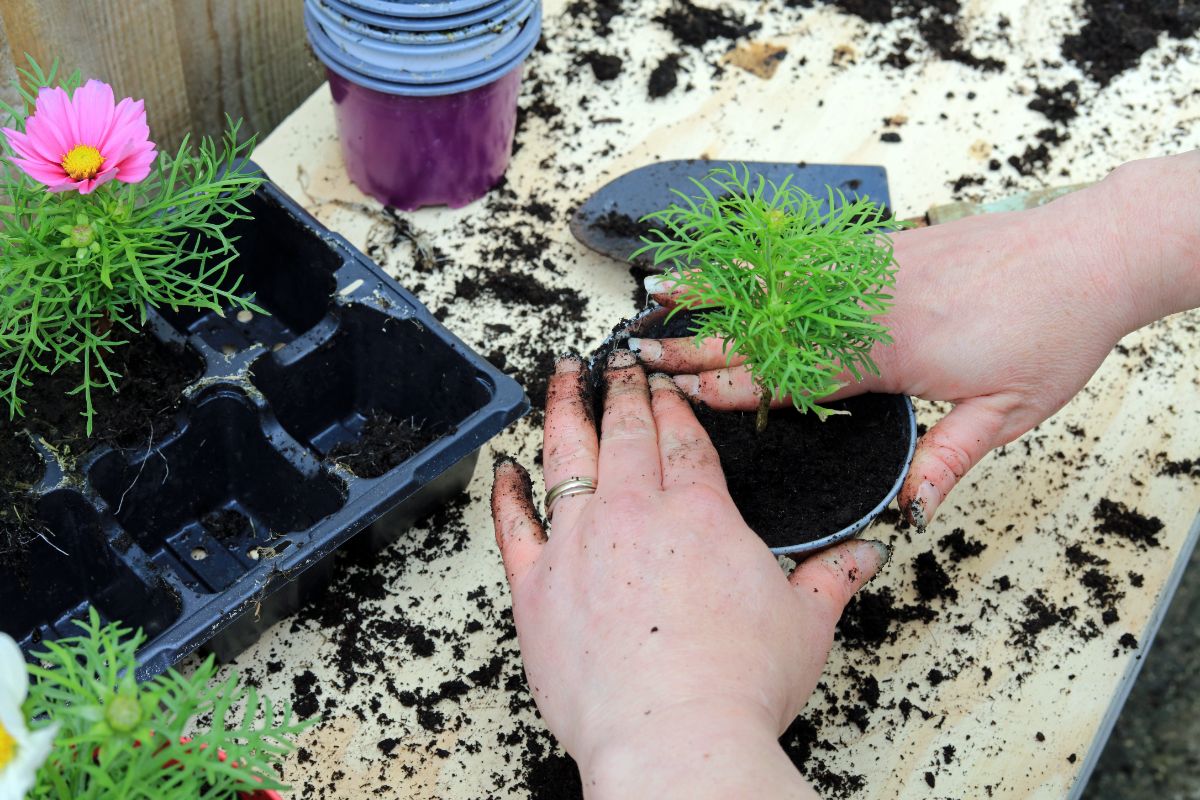
Although cosmos are easy to grow from seeds, it is still most common to begin with a nursery plant. For our directions below, that is what we will focus on. If you want to learn how to grow cosmos from seeds, you can see our sections on propagation which follow.
Ground Planting
1. Decide where to plant the cosmos. You do not need to prep the soil in most cases, though you might want to if you need to raise the pH.
2. Dig holes for the cosmos plants.
What about spacing? American Meadows says, “In the garden, space plants 1 – 2 feet apart, or closer for the shorter types. When planted closely, the large branching stems will support each other yet are susceptible to gray mold, which can spread quickly when conditions are too moist. To curb the development of mold, allow for spacing to ensure that there is enough air circulating in between plants.”
3. Plant the cosmos and backfill the soil.
4. Water well.
Cosmos needs extra water until it is established. After that, you can back off on the watering.
Container Planting
For cosmos in container gardens, follow these planting instructions:
1. Get a pot that is both deep and wide for your cosmos. These plants need plenty of space for their roots. Make sure it has drainage holes.
2. Choose a potting mix to fill your container. A mixture of coconut coir and sand can work well. Whatever you do, do not use potting mix that is especially rich.
3. Plant your cosmos and finish filling in the potting mix.
4. Water well.
How to Propagate Cosmos Plants
Cosmos plants are easily propagated from seeds and cuttings.
Starting Cosmos Plants from Seed
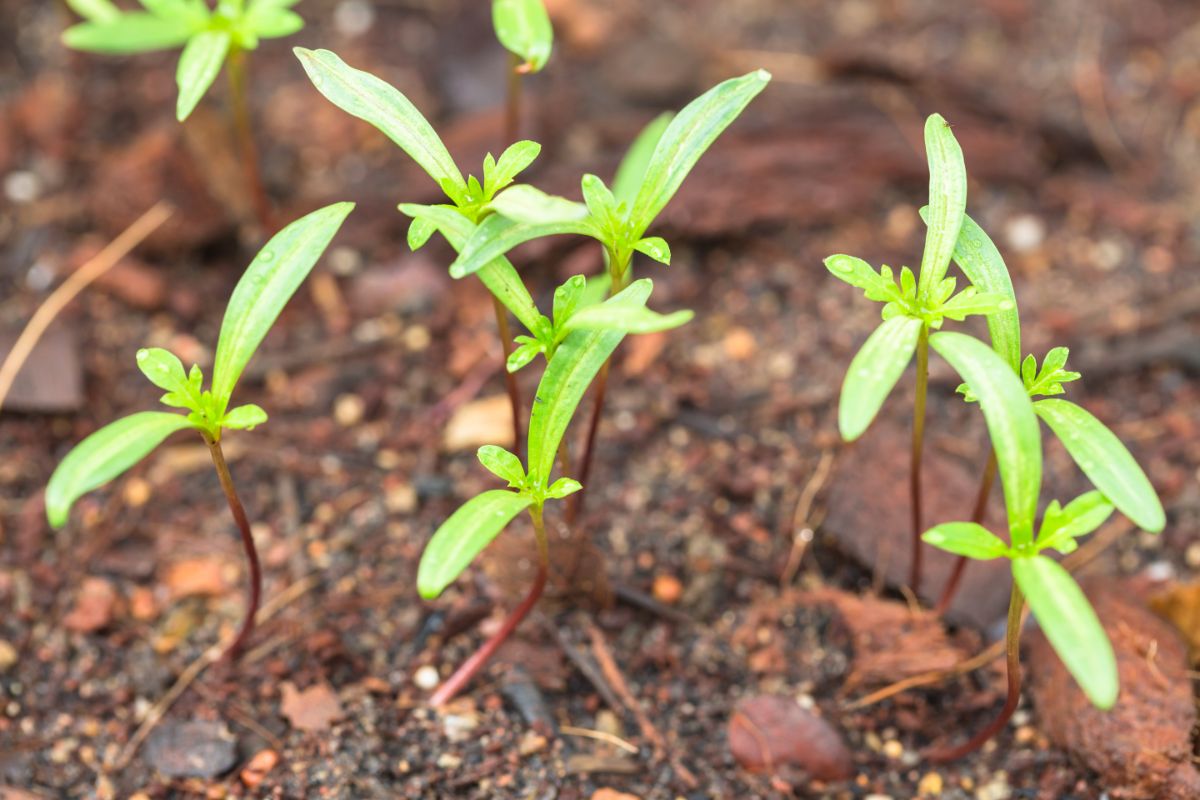
Around 4-6 weeks before you expect the last frost of the year is an ideal time for starting cosmos seeds. Follow these directions:
1. Get seed trays with drainage holes. Fill them with a starting mix.
2. Using a spray bottle, moisten the starting mix.
3. Sow the seeds.
4. Cover the seeds with about a quarter of an inch of potting mix. Make sure it includes vermiculite.
5. Cover the container with a plastic bag or lid to hold in the moisture.
6. Find a warm spot for the seeds to germinate. Either expose them to sunlight or use grow lights.
7. Check on the seeds periodically to see if you need to moisten the potting mix again. Do this for about a week. By that point, it is likely they will sprout.
8. Take the cover off and keep the potting mix moist as the seedlings continue to grow.
9. Eventually, they will be several inches tall. At that point, they need to be transplanted into larger containers. But they may still not be ready to go outdoors.
10. Wait for the weather to warm up. Once there is no further threat of frost, begin the hardening process.
11. Once you have hardened your new cosmos seedlings, you can plant them outside.
That is all there is to it!
Starting Cosmos Plants from Cuttings

If you want, you can propagate cosmos from cuttings using the following instructions:
1. Remove a few side shoots to serve as your cuttings. Each one should have several leaf nodes, and you should make sure that one of them is located right near the base of each cutting.
2. Take the lower leaves off, leaving the upper leaves alone.
Take note that it is critical that the cuttings do not dry out when you are getting them ready to plant. You can spritz them with water as you are taking care of other steps.
3. Get a container with drainage holes and fill it with potting mix.
4. Use a spray bottle to moisten the potting mix.
5. Create small holes in the potting mix by pushing down a chopstick or similar object.
6. Gently insert the cuttings into the holes, then firm up the potting mix around them.
7. Cover the cuttings with a clear plastic bag, staking the bag so that it does not touch the cuttings.
From what we have read, cosmos cuttings are less sensitive to getting wet than most; we have even heard you can water them from the top. But that does not mean that you should trap them with moisture directly on them.
8. Put the cuttings in a location where they can receive indirect sun.
9. Check on your cuttings as they are rooting, and spritz the potting mix whenever it is starting to dry out.
10. Continue to care for the cuttings for three weeks. By then, they probably will have rooted successfully.
11. Harden the new plants.
12. Carefully remove the plants from the container, minding that you do not damage them. They can be fragile.
13. Transplant the new plants outside.
How to Divide Cosmos Plants
We have not found a lot of sources for how to divide cosmos plants, perhaps because a lot of people keep the annual varieties. But you can divide the perennial cosmos. Following the standard instructions you use to divide most of your perennials should work fine. Here is what to do:
1. Get a shovel and dig in a circle around the plant you want to divide. Stay far enough away from the roots that you do not cut into them.
2. Push your shovel underneath the root system to lift the plant up out of the ground.
3. Wipe away the excess dirt.
4. Using a sanitized knife, divide the tubers.
5. Transplant the divided cosmos into their new holes, and backfill the soil and water well.
How to Care for Cosmos Plants

Cosmos are spectacularly easy to take care of, whether you are growing perennial cosmos or annual cosmos. Below, we discuss mulching, staking, and more.
How to Fertilize Cosmos Plants
Guess what? You do not have to fertilize cosmos. In fact, fertilizing them can reduce their blooms and cause them to flop. So, this is one less thing to worry about!
How to Mulch Cosmos Plants
A couple of inches of mulch can be beneficial for cosmos plants since it prevents weeds from crowding up against them. The usual advice applies; make sure not to mulch too close to the stems so that you do not promote rot.
How to Stake Cosmos Plants
You do not typically need to stake shorter cosmos plants, but if you have taller ones, you might need to do it.
Reduce the need for staking by pinching these plants off when they are a couple of feet tall. Doing so will encourage a bushier growth habit.
An alternative option that will prevent you from having to use stakes is just to try growing your tall cosmos plants along a fence. Then, you can use its structure instead.
How to Prune Cosmos Plants
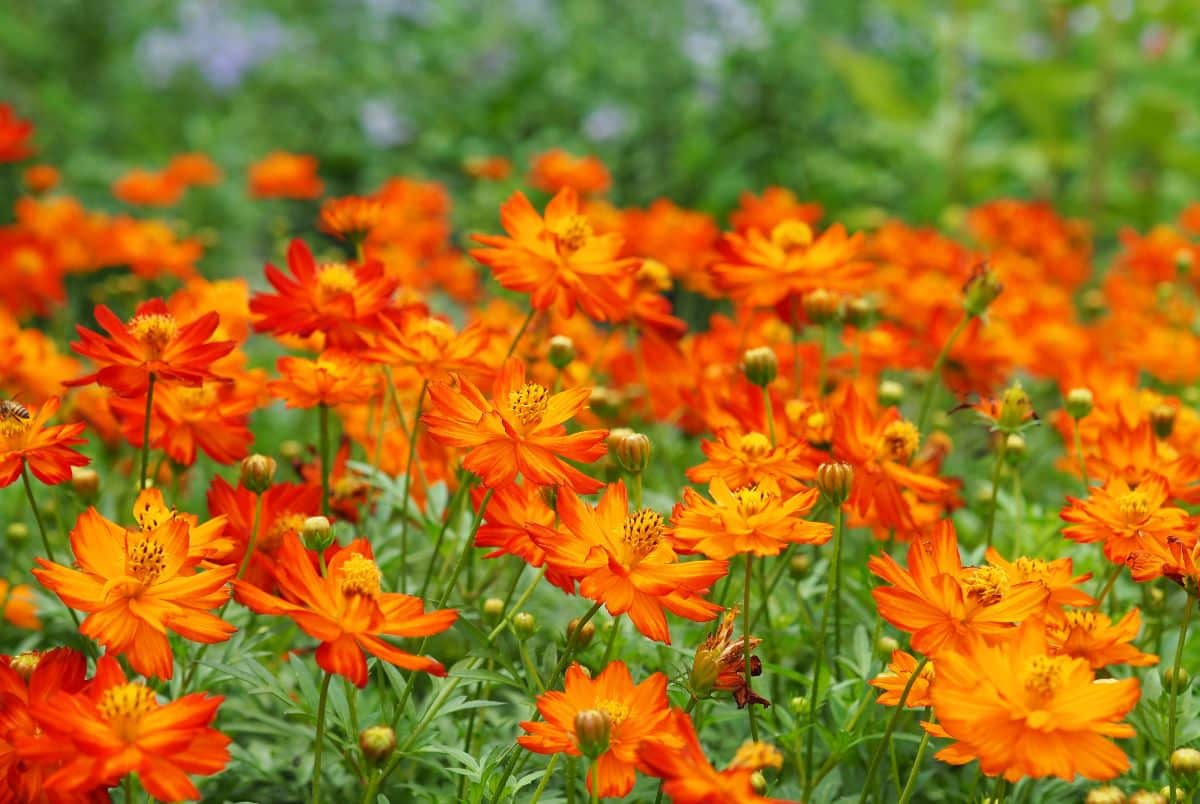
Now, let’s go over what you need to know about pruning cosmos.
How to Deadhead Cosmos Plants
Cosmos is a plant that will reward you if you take the time to deadhead it. American Meadows says, “Keep Cosmos trimmed of spent blossoms to encourage new growth and continuous buds. During mid-summer, instead of just removing the blossoms when deadheading, trim the branches back to a third of the way down the plant; water and wait for a new crop for a late season display.”
If you are diligent about deadheading, you will get to enjoy the entirety of cosmos’ long bloom period.
When to Cut Back Cosmos Plants
We have not seen any sources suggest that it is necessary to trim back cosmos for winter.
Are Cosmos Plants Vulnerable to Diseases or Pests?
Diseases that may affect cosmos plants include powdery mildew, Fusarium wilt, Botrytis blight, phytoplasma-related diseases, and others.
Spacing plants appropriately will help to prevent the development of rot as well as the spread of disease between plants.
Some insects that cause problems for cosmos include fourlined plant bugs, stalk borers, and twospotted spider mites.
Slugs and snails may be particularly problematic when your cosmos plants are young, so you may need to take extra measures to protect them.
Rabbits may eat cosmos, but on the whole, deer are not fond of these plants.
Recommended Planting Combinations for Cosmos Plant

Here are a few plants that are popular companions for chocolate cosmos:
• Daisies: Considering how daisy-like cosmos plants are, it is only natural to plant them alongside actual daisies. Thankfully, daisies like the same conditions, so they do very well together.
• Poppies: These flowers, with their warm hues, can complement a variety of different types of cosmos nicely. See our Poppies Full Growing Guide.
• Dianthus: Also known as “pinks,” these small flowers are a delightful accompaniment for your cosmos. Check out our Dianthus Full Growing Guide.
Cosmos Plant Landscaping Ideas
What are some of the ways you can use cosmos to beautify your outdoor spaces? Here are a few landscaping ideas.
• Plant cosmos along a fence. The benefit to doing this is that you can use it for staking the taller types, plus the effect is gorgeous.
• Cosmos can work nicely in a container garden on your patio.
• Like most other perennials, cosmos can make an excellent border plant.
• Another thing you can do with cosmos is spread it out across a large section of your garden to achieve a kind of “wild” look.
Recommended Cosmos Plant Varieties
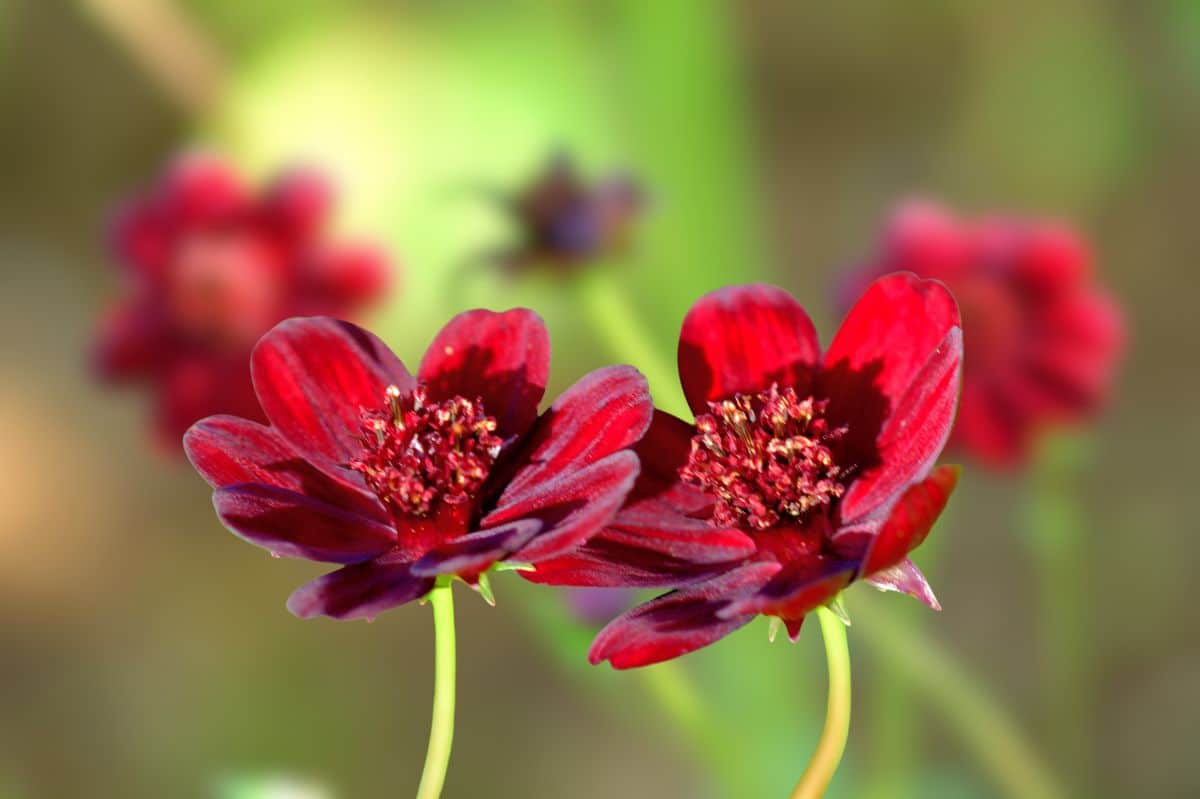
If you want perennial cosmos, then what you are in the market for is generally chocolate cosmos. Here are the names of a few well-known cultivars:
• Choca, a.ka.a. Chocamocha
• Dark Secret
• Eclipse
• Spellbound
• Black magic
Chocolate cosmos may range in color from a deep brownish red to a color that is close to black.
Along with chocolate cosmos cultivars, there are also numerous annual cosmos varieties you can choose from. Whatever you go with in your garden, you are sure to be delighted by these easy-grow blooms.
Frequently Asked Questions About Growing Cosmos Plants
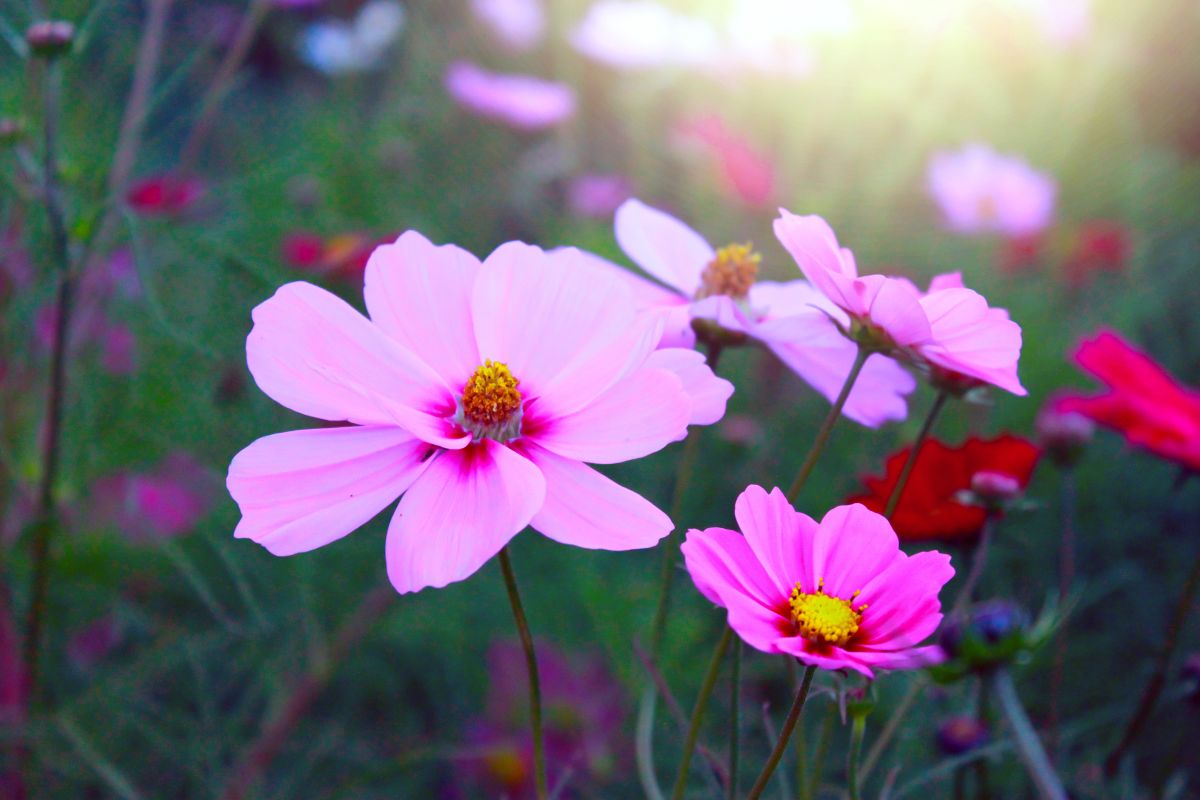
Slugs, snails, insects, and rabbits may also sometimes eat cosmos plants. You will need to assess the damage to make an educated guess about which it is in your case.
Whether or not cosmos is edible depends on which species you get. Some are, some are not. If you get an edible type, then you can try making tea with the petals or using them to add color to a salad.
No, cosmos plants are not toxic to cats or dogs.
Yes, the annual varieties of cosmos do seed themselves without any intervention from you. That means that you should see more of them next year.
Your perennial cosmos can go to seed as well, but the original plants will also return year after year.
Where to Buy Cosmos Plants

If you want to shop the biggest selection of annual and perennial cosmos plants, we recommend you look online. Enjoy growing this easy, low-maintenance flower in your garden.


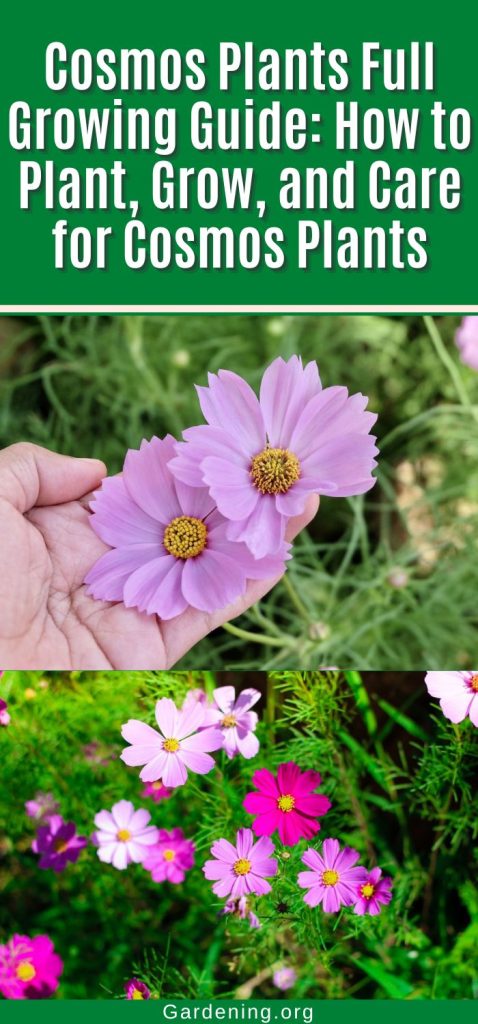






Bonnie Fleming
Wow! Such an interesting article. Covering all my questions for sure. Thank you.